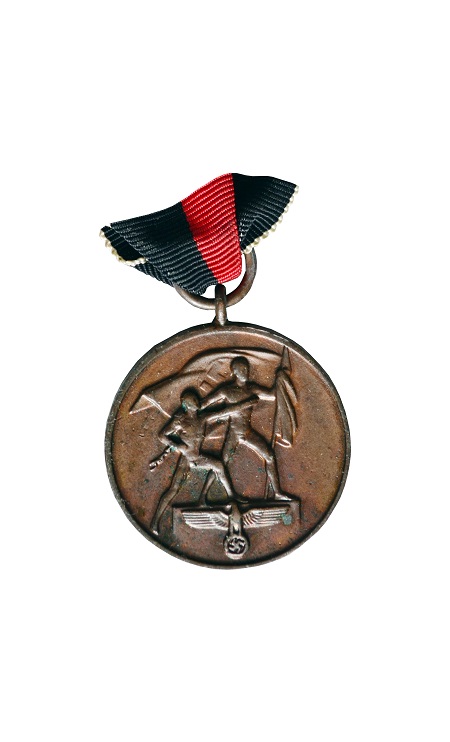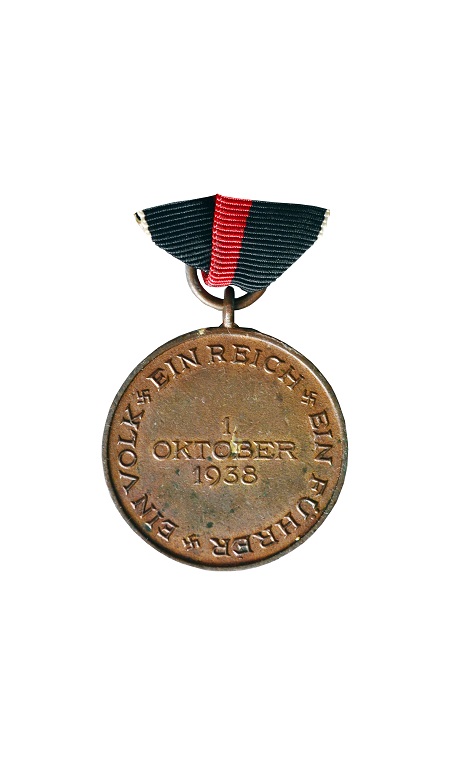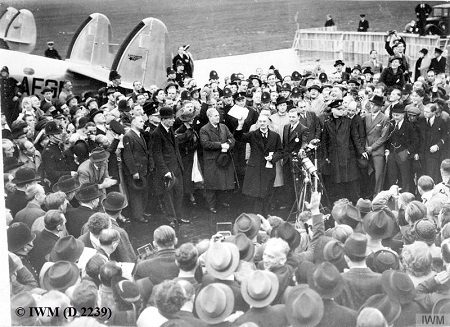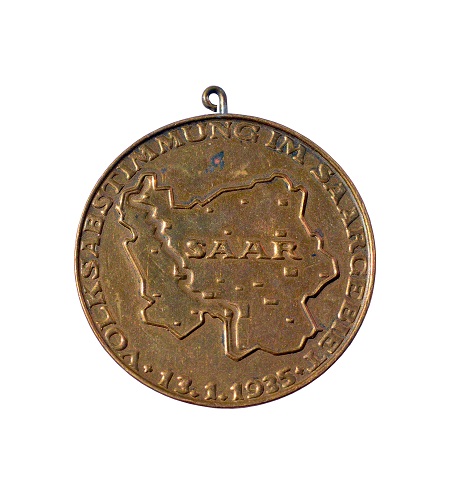German takeover of the Sudetenland 1938 and Czechoslovakia 1939
After World War I, Austria-Hungary broke apart. Late in October 1918, an independent Czechoslovak state, consisting of the lands of the Bohemian kingdom and areas belonging to the Kingdom of Hungary, was proclaimed and was recognized by the international community. However, these lands according to the 1921 census, contained over 3 million ethnic Germans — 23.4% of the total population. The controversies between the Czechs and the German-speaking minority (which constituted a majority in the Sudetenland area of the country) lingered on throughout the 1920s. This intensified in the 1930s as the Great Depression heavily impacted industry and employment in the Sudetenland and led to a rise in German Nationalism and the establishment of a Sudeten Nazi party.
 German 1st October 1938 Medal for military personnel taking part in the occupation of the Sudetenland.
German 1st October 1938 Medal for military personnel taking part in the occupation of the Sudetenland.

Immediately after the Anschluss of Austria into the Third Reich in March 1938, Hitler made himself the advocate of ethnic Germans living in Czechoslovakia, triggering the "Sudeten Crisis". The following month, Sudeten Nazis, led by Konrad Henlein, agitated for autonomy. Throughout August and September efforts were made by the British and French governments to broker a solution and agree a cession of the Sudetenland to Germany. No Czechoslovak representative was invited to these discussions.

Chamberlain met Hitler in Godesberg on September 22 to confirm the agreements. Hitler however, aiming to use the crisis as a pretext for war, now demanded not only the annexation of the Sudetenland but the immediate military occupation of the territories, giving the Czechoslovak army no time to adapt their defence measures to the new borders. To achieve a solution, Italian dictator Benito Mussolini suggested a conference of the major powers in Munich and on September 29, Hitler, Daladier and Chamberlain met and agreed to Mussolini's proposal (actually prepared by Hermann Göring) and signed the Munich Agreement, accepting the immediate occupation of the Sudetenland. The Czechoslovak government, though not party to the talks, submitted to compulsion and promised to abide by the agreement on September 30.

Control of the Sudetenland passed to Germany during October 1938. The Czech lands now lay defenceless, with their border fortifications having being lost with the Sudetenland. As a consequence, deserted by the West, the Czechs were unable to resist the subsequent German invasion in March 1939. However, Britain and France now realised that their policies of appeasement towards Hitler had failed and nothing short of war was going to halt his expansionist ambitions.
After World War I, Austria-Hungary broke apart. Late in October 1918, an independent Czechoslovak state, consisting of the lands of the Bohemian kingdom and areas belonging to the Kingdom of Hungary, was proclaimed and was recognized by the international community. However, these lands according to the 1921 census, contained over 3 million ethnic Germans — 23.4% of the total population. The controversies between the Czechs and the German-speaking minority (which constituted a majority in the Sudetenland area of the country) lingered on throughout the 1920s. This intensified in the 1930s as the Great Depression heavily impacted industry and employment in the Sudetenland and led to a rise in German Nationalism and the establishment of a Sudeten Nazi party.
 German 1st October 1938 Medal for military personnel taking part in the occupation of the Sudetenland.
German 1st October 1938 Medal for military personnel taking part in the occupation of the Sudetenland.
Immediately after the Anschluss of Austria into the Third Reich in March 1938, Hitler made himself the advocate of ethnic Germans living in Czechoslovakia, triggering the "Sudeten Crisis". The following month, Sudeten Nazis, led by Konrad Henlein, agitated for autonomy. Throughout August and September efforts were made by the British and French governments to broker a solution and agree a cession of the Sudetenland to Germany. No Czechoslovak representative was invited to these discussions.

Chamberlain met Hitler in Godesberg on September 22 to confirm the agreements. Hitler however, aiming to use the crisis as a pretext for war, now demanded not only the annexation of the Sudetenland but the immediate military occupation of the territories, giving the Czechoslovak army no time to adapt their defence measures to the new borders. To achieve a solution, Italian dictator Benito Mussolini suggested a conference of the major powers in Munich and on September 29, Hitler, Daladier and Chamberlain met and agreed to Mussolini's proposal (actually prepared by Hermann Göring) and signed the Munich Agreement, accepting the immediate occupation of the Sudetenland. The Czechoslovak government, though not party to the talks, submitted to compulsion and promised to abide by the agreement on September 30.

Control of the Sudetenland passed to Germany during October 1938. The Czech lands now lay defenceless, with their border fortifications having being lost with the Sudetenland. As a consequence, deserted by the West, the Czechs were unable to resist the subsequent German invasion in March 1939. However, Britain and France now realised that their policies of appeasement towards Hitler had failed and nothing short of war was going to halt his expansionist ambitions.

This map shows the demarcation line of the 22nd September 1939, partitioning Poland between Germany and the Soviet Union. The partition of Poland had been agreed as part of a non-aggression agreement between the two countries contained within the Molotov–Ribbentrop Pact of August 1939. The world had been stunned at this agreement between these two ideologically opposed super powers. The Germans had invaded Poland on 1st September 1939, with the Soviet Union commencing their offensive on eastern Poland on the 17th September, thus sealing Poland's fate.


Germany - Saar Plebiscite Commemorative Medal 13th January 1935
Issued to commemorate the plebiscite held to determine the future of the Saar, the small German coal mining region, which had been separated from Germany at the end of WW1. The plebiscite was overseen by contingents of foreign troops including Britain and the vote was decisive, with a 90% majority voting for a return to Germany. Inscribed on the rear "Germany the Saar forever".
Issued to commemorate the plebiscite held to determine the future of the Saar, the small German coal mining region, which had been separated from Germany at the end of WW1. The plebiscite was overseen by contingents of foreign troops including Britain and the vote was decisive, with a 90% majority voting for a return to Germany. Inscribed on the rear "Germany the Saar forever".

German "tinnie" badge celebrating the return of the Saarland to the German Reich.

Postcard dated 8th October 1938, sent to celebrate the annexation of the Sudetenland. The card depicts a map of Greater Germany with the Sudetenland represented by the shaded area. The caption on the card reads "Ein Volk, Ein Reich, Ein Fuhrer!"
Back
